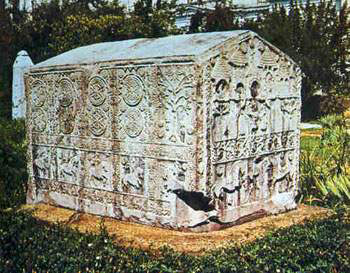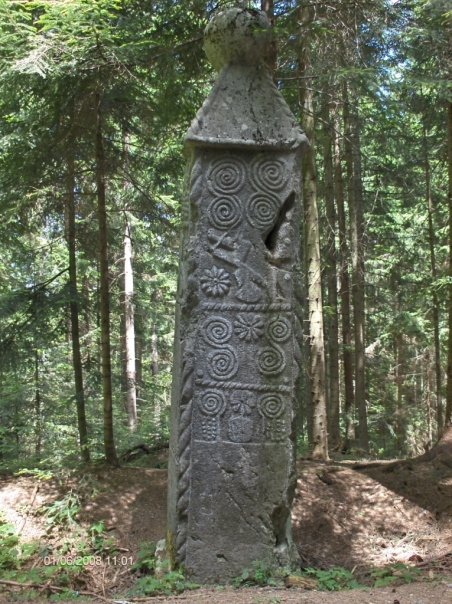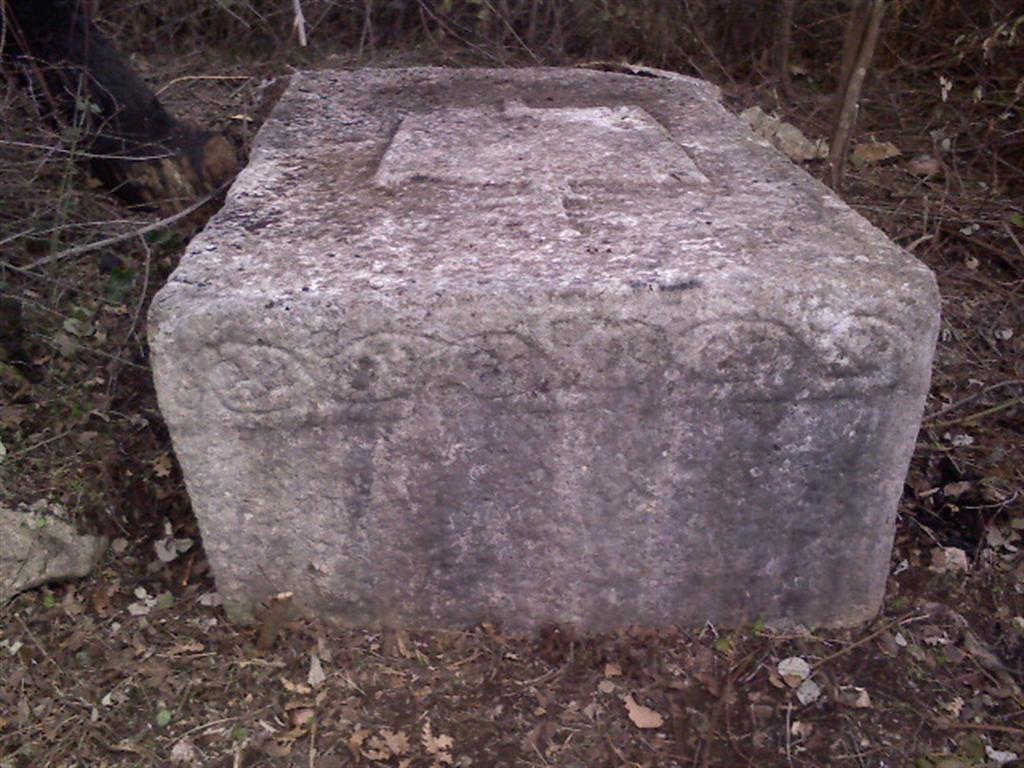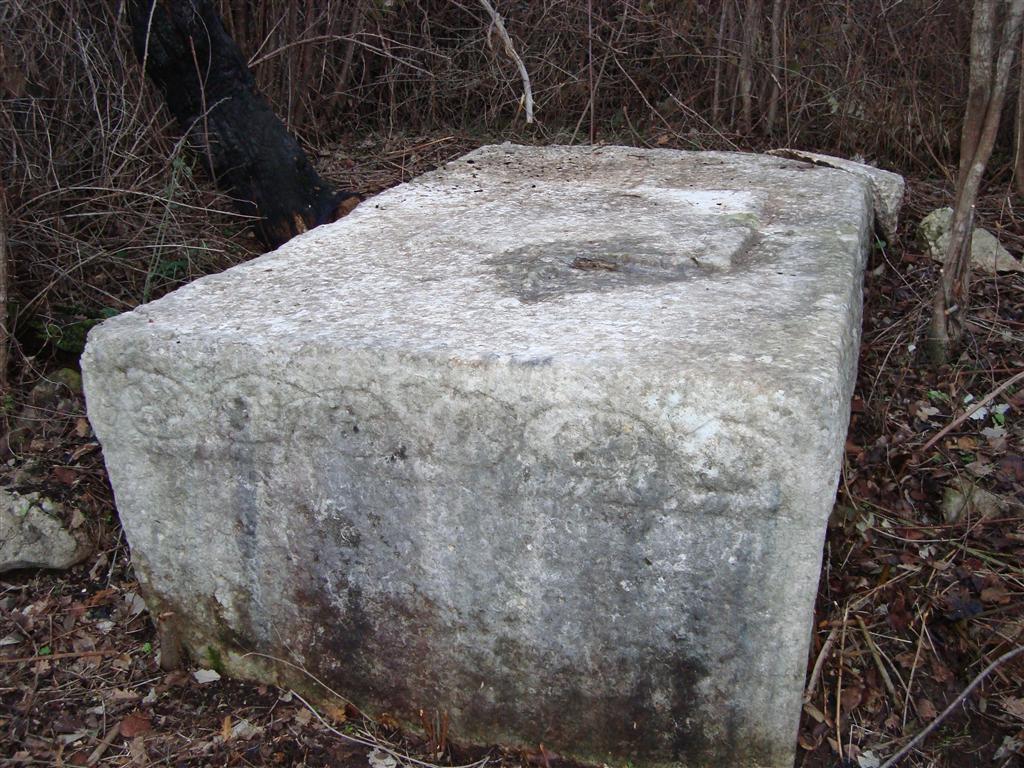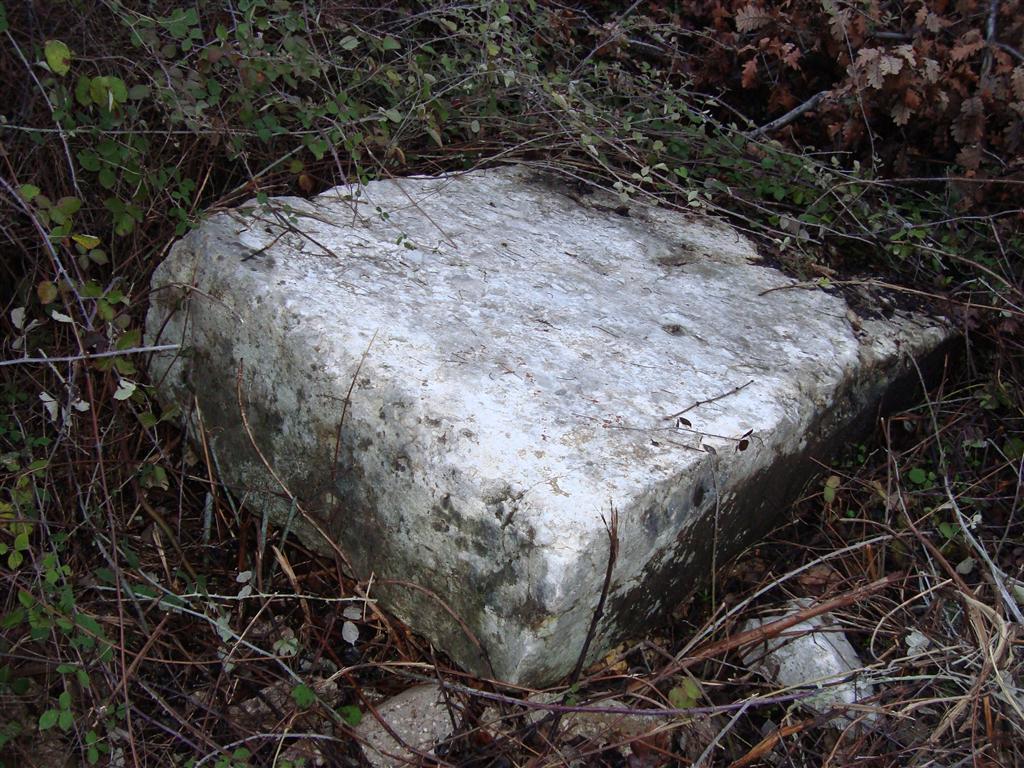Stećci are monumental medieval tombstones that lie scattered across the landscape of Bosnia and Herzegovina. They are the country's most legendary symbol. These are the tombstones of those who lived between the
11th and 15th centuries and refused to swear allegiance to any kingdom but their own or to be swayed by any influence. Instead they stayed true to themselves and to what they could find only within themselves and in Bosnia.
 Their most remarkable feature is their decorative motifs, many of which remain enigmatic to this day. These motifs depict knights in armor, hunters hunting, farmers in the fields, warriors competing in tournaments, rearing horses, dancers, ladies in dresses, flowers, wolves, bears, wild boars and dogs. Among favored ornaments were the crescent moon, stars, cross and swastika. The images celebrate life, joy, physical strength, and merriment. Questioning of death and oblivion appears in some of the inscriptions but is absent in the carved images. They are around 80 primary and 320 secondary motifs found on about 7 500 Stećci.
Their most remarkable feature is their decorative motifs, many of which remain enigmatic to this day. These motifs depict knights in armor, hunters hunting, farmers in the fields, warriors competing in tournaments, rearing horses, dancers, ladies in dresses, flowers, wolves, bears, wild boars and dogs. Among favored ornaments were the crescent moon, stars, cross and swastika. The images celebrate life, joy, physical strength, and merriment. Questioning of death and oblivion appears in some of the inscriptions but is absent in the carved images. They are around 80 primary and 320 secondary motifs found on about 7 500 Stećci.
These stone slabs are sometimes as heavy as 30,000 kilograms and vary in shape. Sometimes they take the shape of a roofed sarcophagus, sometimes of a high pillar, an ordinary flat slab, a chest in the shape of a elongated cube with flat surfaces, or simply an irregular roughly hewn monolith. On average they are two meters long and one meter wide. The slates are between 30 and 50 centimeters high and the sarcophagi and tombs are approximately 1.5 meters in height. The height of the pillars ranges from two to three meters.
Stećci are gruped in what is known as Nekropola which is a graveyard, and almost all of the Nekropola (graveyards) are located on hills overlooking the surrounding country-side where those who truly loved this country with their hearts and souls trace their roots.
Location of Stećci on the map of Bosnia and Herzegovina and surrounding area that use to be part of the Kingdom of Bosnia
Today there are about 69 356 known Stećci in existence found at 3162 locations, among all recorded Stećci, relief motifs were found on fewer than 6,000 and the inscriptions on fewer than 400. Most of the Stećci are located with in the borders of modern Bosnia and Herzegovina, however they can also be found in the places where people of Bosnia an Herzegovina settled or with in the borders where Kingdom of Bosnia extended to. To put this in to perspective the number of Stećci found in Bosnia and Herzegovina is 59 593 or 85.92%, followed by parts of Croatia mainly in Dalmatia 4 447 or 6.41%, Montenegro 3 049 or 4.4% and Serbia 2 267 or 3.27%.
In regards to collected and combined results it is necessary at this point to mention the fact that over time a number of stećaks was destroyed. We are convinced that this number is not small. Small numbers of stećaks have been lost over time due to poor quality of the stone, but much larger number of stećaks, due to the lack of understanding and incomprehension of values for these monuments, was used to build religious buildings, residential buildings, roads, bridges and other structures. According to our assessment, this could account for destruction of at least 20% of the stećaks.
What does this gathered information tell us about the number and geographical position of stećaks and how they can be explain it?
First of all, it is indisputable that the stećaks are specific for medieval Bosnia and Hum, or Bosnia and Herzegovina, and that they are distributed in all its parts. Fact of unequal distribution, circumstances that stećci in some regions are rare and in the other none existent one can explain. Some mountainous, karst and inhospitable places were not even in the Middle Ages suitable for the settlements, even for those temporary - suitable for summer, or livestock, for example some parts of Prenj, Čvrsnica, Bjelašnica and Velež, which is why there are no stećaks. Some regions of northern Bosnia were long under the domination of Hungary who did not tolerated the existence and operation of the >> Bosnian Church <<, which was followed by vast majority of the population, but also the existence of Bosnian state, and especially its independence. It is therefore understandable that in the regions from Banja Luka and Jajce to Tuzla and Bijeljina did not have many stećaks. This is because there have been a frequent wars and population displacements in those regions, which is why the existence of favourable conditions for a freer life of Bosnians did not exist. In addition to, these regions were less suitable for medieval livestock farming, as well as for trade, which was mostly related to livestock products. North-western parts of Bosnia until the end of the 14th century were not an integral part of the medieval Bosnian, but the Hungarian-Croatian state, which is why the occurrence of stećci less frequent. The western and south-western regions of Bosnia and Herzegovina had long been under strong influence of Bosnia and Hum, under the rule of ban Stephen II Kotromanić, especially under the king Tvrtko I, and even later during the rule of Hrvoje Vukčić and herzog Stephen Vukčić -Kosača, organized and full control of Bosnian rule stretched far beyond the present day borders. That is why the regions around Duvno, Livno and Glamoč and Posušje, Grude and Ljubuški have quite a large number of stećaks. The relatively lower density of stećaks in some areas of central Bosnia – around Fojnica, Visoko, Kakanj and Zenica, the so-called Kings lands, has its reasons. Due to rapid social change and intense development is why there was least care shown to preserve these monuments. The appearance of cities and marketplaces, primarily related to the mining centres, and consequently the creation and inception of civil class, in our opinion, was a factor that influenced the gradual decline of custom of placing stećaks, which primarily affected this part of Bosnia. Also, there were a large number of inhabitants from Dubrovnik, Saxons and other foreigners, who have had their customary burial practises. In addition, due to the persecution of followers of the Bosnian Church by the king Tomaš and Stevan Tomašević, large numbers of population emigrated to the south and southeast, where they enjoyed the protection firstly from Sandalj Hranić, later even greater protection of herzog Vukčić, and indirectly, from Turks themselves. Due to the best conditions for stećaks, the abundance of stone and good stonemasons, it is understandable then why Herzegovina is characteristic by the number and quality of the stećaks.
The existence of stećaks outside the borders of present Bosnia and Herzegovina has its justification. First of all, we must bear in mind that the borders of medieval Bosnia and Hum (Herzegovina), were different. During the rule of ban Stephen II Kotromanić they reached the Adriatic coast and the river Cetina, including the town of Omiš, and during the rule of King Tvrtko I, from 1378 - 1390, they were extended to include the lands near Zadar, including the cities of Split, Trogir and Šibenik, the islands of Brać, Hvar and Korčula. They were later extended by Herzog Stephen to Cetina and later by Hrvoje Vukčić beyond Šibenik. Under the rule of Bosnia, and before that of Hum, was for a long time Suton Coast and a part of Konovala, and during the Tvrtko I town of Kotor. It is known that the Tvrtko I took Polimlje from Nikola Altomanović and was crowned in Mileševa. Sandalj Hranić as a Grand Duke built a fortress Soko on Piva where he often resided, ruling large area all the way to Kotor, and Herzegovina of his successors have included Pljevlja, Prijepolje, Bijelo Polje, Žabljak, Nikšić and Herceg Novi. These facts explain the appearance of stećaks in the west to Trogir and Šibenik, in the south to Stona including Pelješac, then to the coast of Dubrovnik, Župa and Konavla, and on the east all the way to the Bijelo Polje and Prijepolje, this is because wherever the subjects of Bosnia and Hum (Herzegovina) lived and died, regardless of whether they were members of the Bosnian, Catholic or Orthodox churches, stećaks were placed on their graves.
We believe that the borders of medieval Bosnia were not an exclusive factor in geographical positioning of stećaks. Tradition or custom of making and placing stećaks on the graves outside the borders of the Bosnian state was carried by its subjects who had settled outside Bosnia for various reasons in different times. There were migrations to west as well as to the south and north during the 15th century due to the danger of Ottomans. In such circumstances, most emigrated to the Imotski region, Makarska Riviera and around the Split, where they temporarily or permanently settled. A significant number of Bosnians settled in the parts of Croatia by the end of 15th century together with the Turks, or promptly after that, when the Turkish rule was established. This applies especially to settling of Vlachs and other Christian or non-Christian population when it comes to Bosnian Posavina and other Hungarian or Croatian lands across the river Una and Sava. Hence the appearance of stećaks, which in our opinion, falls into the final period of their existence - the end of 15th and early 16th century.
There is an interesting case of stećaks appearing in Cetinje, which is quite far away from the other areas with stećaks in Montenegro. By popular cultural belief, Wallach church in Cetinje was built by the sons of Ivan Borojev, immigrants from the Old Vlach, about 1450, next to the church they founded the cemetery of their fraternity (bratstva). Of this necropolis till present there are still two stećaks remaining. However, we think it is more likely to be a different reason for that which we would like to express here. Recently I. Božić was writing about katuns of Montenegro, in which he stated that Stefan Crnojević quell a (Grabaljski) rebellion by using settlers from Herzegovina [150]. It refers to numerous families (who by some are called Vlachs) who settled in Paštrovići and surrounding regions of Montenegro during the time of Sandalj, and maybe even earlier. This could be the motive and cause of stećaks in Cetinje, and possibly the reason why the Wallach church was built. In this regard, we note the existence, in early historical literature, of the stećci in Vuči Dol, in Katunjska nahija, where the Orthodox Church of St. Ilija was built, and where stećaks were used for the construction of the church [151]. Vuči Do is located approximately 30 km (by air) to the southeast of Cetinje. That would also mean that there were immigrants from Herzegovina in close proximity of Cetinje.
There were also economic migrations that resulted in the appearance stećaks on the Croatian-Hungarian territory, and also in Serbia & Montenegro and Dubrovnik. As well as marriage relations on all sides, and other contributing factors for appearance of stećaks in those places were: trade, crafts and even political ties.
From all this it is evident that stećaks are original Bosnian occurrence. On this matter, it seems that it is primarily related to the privileged layer of the Bosnian feudal society - feudal lords who thought that stećaks were suitable term of manifestation of their social position. Soon it became appealing to other economically better-off classes - lower feudal lords, free peasants, and especially for the Vlachs, who with their clever knack and knowhow ensured for themselves a privileged position not only in the medieval Bosnian state, but also during Ottoman rule. Understandably, there were also influenced by other factors, such were relief of terrain and relative isolation from outside (foreign) influence and wealth of stone as a material for stećaks. Since feudals and their loyal subjects accepted >> Bosnian Church << as their own, it seemed that the stećaks were of Bogomil background. Through this impression has been contributed by the fact that the feudal lords began be buried >> na svom plemenitom (on their noble land) <<, >> na svojoj baštini (on their heritage) <<, therefore, beyond the previously normal, organized and blessed burial grounds, this could also be considered heretical. We think that the phenomenon stećaks cannot unilaterally be treated, because it certainly is not just an expression Bogomilism or specialty of Vlachs, as it was considered by some historians [152], but we must observe its social character and understand it as a product of relationships already developed in the Bosnian feudal system.
The most famous and decorated stećak is from Zgošća near Kakanj in Bosnia and Herzegovina, from 15th century. Although it has no engraved writing, since it was immaculately decorated, it is suggested that it belonged to King Stjepan II Kotromanić.
Stećak from Zgošća near Kakanj in Bosnia and Herzegovina
References:
1. Šefik Bešlagić, Stečci Kataloško – topografski pregled, Pages 43-45.
2. I. Bozic, »Katuni Crne Gore«, Zbornik Filozofskog fakulteta, knj.X-I, Beograd 1968,245-249. [150]
3.DrJ.Erdeljanovic,Stara Crna Gora,Srp.etn.zb., Naselja, knj.24, Beograd 1926,494. [151]
4. Dr A. Solovjev,Bogumilska umjetnost,Enciklopedija Jugoslavije I, Zagreb 1955,644-645; Isti, Simbolika srednjevjekovnih nadgrobnih spomenika u Bosni i Hercegovini, Godisnjak Istorijskog drustva BiH, Sarajevo 1956, 5-67. M.Wenzel, Bosnian and Herzegovinian tombstones-Who made them and why, Stidost-For schungen XXI, Munchen 1962, 102-143 [153]




